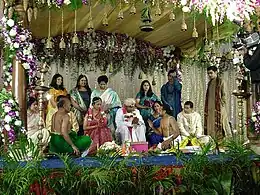Wedding mandapa
A Vivaha Mandapa (Sanskrit: विवाह मण्डप, romanized: Vivāha Maṇḍapa, lit. 'Wedding pavilion'),[1][2] also referred to as Kalyana Mandapa (Sanskrit: कल्याण मण्डप, romanized: Kalyāṇa Maṇḍapa)[3] or simply Wedding mandapa is a mandapa (pavilion)[4][5] temporarily erected[6] for the purpose of a Hindu or Jain wedding. It is the term used for the wedding canopy in Dharmic religions.[7][8] The main wedding ceremonies take place under this mandapa. Vivaha Mandapas have historically also been featured adjacent to Hindu temples to commemorate the wedding of Hindu deities, such as Rama and Sita.[9]

Description
A Vivaha Mandapa is traditionally made of wood, although in the contemporary period, modern materials are sometimes used.[10] It is often set up as an arrangement that includes pillars supporting a frame, royal chairs for the bride and the groom, side chairs for parents, and a pedestal for the sacred fire.
It is often rented from businesses that specialise in renting items for an Indian wedding. Its use is common among overseas Indians as well.[11]
The use of a mandapa is an ancient custom, and is described in texts like Ramacharitamanas[12] and various Sanskrit texts. The bride is often escorted to the mandapa by her maternal uncle.[13]
Usually, a mandap will be made of four posts, in a Vivaha Mandapa holds symbolic and ritualistic significance within Hindu culture. These four posts represent various aspects and concepts associated with Hindu beliefs and marriage rituals:
- Four Vedas: The four posts of the Vivaha Mandapa symbolize the four Vedas, which are ancient sacred texts in Hinduism. These Vedas (Rigveda, Samaveda, Yajurveda, and Atharvaveda) are considered the foundation of Hindu knowledge and spirituality. The presence of the Vedas in the wedding pavilion signifies the importance of knowledge and wisdom in a marital relationship.
- Four Stages of Life: Hinduism recognizes four stages of life, known as "Ashramas." These stages are Brahmacharya (student life), Grihastha (householder life), Vanaprastha (retired life), and Sannyasa (renunciant life). The Vivaha Mandapa represents the Grihastha Ashrama, the stage when individuals enter married life and fulfill their worldly responsibilities.
- Four Goals of Life (Purusharthas): The four posts also symbolize the four purusharthas, which are the fundamental goals of human life according to Hindu philosophy. These goals are Dharma (righteousness and duty), Artha (prosperity and wealth), Kama (desires and enjoyment), and Moksha (liberation and spiritual enlightenment). Marriage is seen as a means to pursue these goals in a balanced and harmonious way.
- Four Directions: The four posts of the Vivaha Mandapa may also represent the four cardinal directions (north, south, east, and west). In Hindu culture, these directions are associated with various deities, energies, and elements. The presence of the four posts signifies the blessings and protection of these cosmic forces on the couple entering into wedlock.
- Stability and Balance: The structural design of the Vivaha Mandapa with its four posts offers stability and balance, which are essential qualities in a successful marital relationship. Just as the four posts support the pavilion, a marriage requires a strong foundation and support to flourish.
It's important to note that interpretations and symbolism may vary based on regional and cultural differences within Hinduism. The presence of four posts in the Vivaha Mandapa reflects the deep spiritual and philosophical underpinnings of Hindu marriage ceremonies and the holistic approach to human life that Hinduism emphasizes.
Decorations
Traditionally, the wedding mandapa is decorated using kalashas (pots filled with water), garlands of mango leaves, coconuts, banana leaves, and other traditional objects.
Modern mandapas use fabrics, lights, crystals, flowers, Wrought Iron unique shapes and other materials insuring all religious aspects of a mandapa, which include the four pillars and havana kunda (fire altar) is now completely modernised by design.[14]
See also
References
- Choudhary, Indra Kumar (1988). Some Aspects of Social Life of Medieval Mithila, 1350-1750 A.D.: With a Special Reference to Contemporary Literatures. Kashi Prasad Jayaswal Research Institute. p. 138.
- Jayashanker, S. (2003). Temples of Kōzhikkōde District. Controller of Publications. p. 79.
- Tilak, Sudha G. (2019-10-15). Temple Tales: Secrets and Stories from India's Sacred Places. Hachette India. p. 115. ISBN 978-93-88322-47-8.
- Ratra, Amiteshwar (2006). Marriage and Family: In Diverse and Changing Scenario. Deep & Deep Publications. p. 198. ISBN 978-81-7629-758-5.
- Dash, Trilochan (2020-06-05). Upajamana - The Sacred Hindu Marriage Ceremony: Vedic Hindu Wedding Rituals. Trilochan Dash. p. 45.
- Rituals & Customs of a Hindu Wedding: Design & Planning Guide by Kavita Kapoor
- Napier, John (4 June 2013). They Sing the Wedding of God: An Ethnomusicological Study of the Mahadevji ka byavala as Performed by the Nath-Jogis of Alwar. McFarland. p. 301. ISBN 978-1-4766-0213-4.
- Brill, Alan (31 October 2019). Rabbi on the Ganges: A Jewish-Hindu Encounter. Rowman & Littlefield. p. 210. ISBN 978-1-4985-9709-8.
- Knapp, Stephen (2008-05-29). Seeing Spiritual India: A Guide to Temples, Holy Sites, Festivals and Traditions. iUniverse. p. 192. ISBN 978-0-595-61452-3.
- "विवाह मंडप नए रूप में". hindi.webdunia.com (in Hindi). Retrieved 2023-07-28.
- Marrying East and West From Henna to Horses, Hindu Wedding Traditions Call for Specialized Help https://www.washingtonpost.com/wp-dyn/articles/A40091-2004May19.html
- Balkand, 320
- A Maharashtrian marriage http://www.indianexpress.com/res/web/pIe/ie/daily/19990202/ile02185.html
- "The Shastra behind your Wedding Mandap design — The Tamarind Tree". Best Heritage Wedding Venues in Bangalore - The Tamarind Tree. Retrieved 2023-04-22.